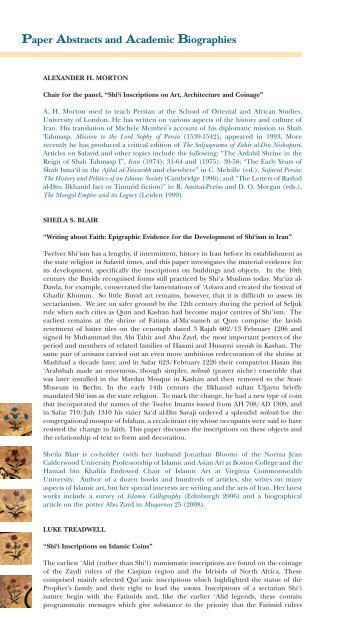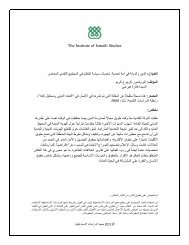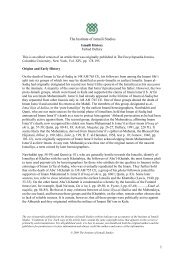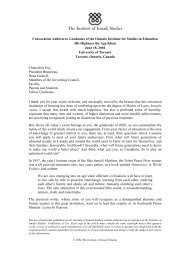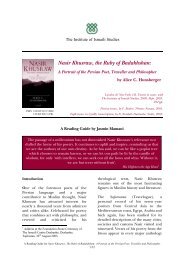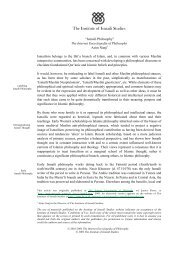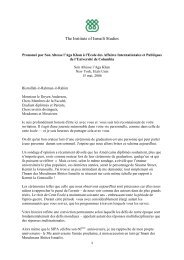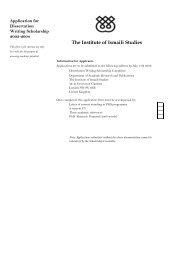BM-IIS Conference Pack.qxp - The Institute of Ismaili Studies
BM-IIS Conference Pack.qxp - The Institute of Ismaili Studies
BM-IIS Conference Pack.qxp - The Institute of Ismaili Studies
You also want an ePaper? Increase the reach of your titles
YUMPU automatically turns print PDFs into web optimized ePapers that Google loves.
<strong>BM</strong>-<strong>IIS</strong> <strong>Conference</strong> <strong>Pack</strong>.<strong>qxp</strong> 20/03/2009 14:13 Page 17<br />
Paper Abstracts and Academic Biographies<br />
ALEXANDER H. MORTON<br />
Chair for the panel, “Shi‘i Inscriptions on Art, Architecture and Coinage”<br />
A. H. Morton used to teach Persian at the School <strong>of</strong> Oriental and African <strong>Studies</strong>,<br />
University <strong>of</strong> London. He has written on various aspects <strong>of</strong> the history and culture <strong>of</strong><br />
Iran. His translation <strong>of</strong> Michele Membré’s account <strong>of</strong> his diplomatic mission to Shah<br />
Tahmasp, Mission to the Lord Sophy <strong>of</strong> Persia (1539-1542), appeared in 1993. More<br />
recently he has produced a critical edition <strong>of</strong> <strong>The</strong> Saljuqnama <strong>of</strong> Zahir al-Din Nishapuri.<br />
Articles on Safavid and other topics include the following: “<strong>The</strong> Ardabil Shrine in the<br />
Reign <strong>of</strong> Shah Tahmasp I”, Iran (1974): 31-64 and (1975): 39-58; “<strong>The</strong> Early Years <strong>of</strong><br />
Shah Isma‘il in the Afdal al-Tawarikh and elsewhere” in C. Melville (ed.), Safavid Persia:<br />
<strong>The</strong> History and Politics <strong>of</strong> an Islamic Society (Cambridge 1996); and “<strong>The</strong> Letters <strong>of</strong> Rashid<br />
al-Din: Ilkhanid fact or Timurid fiction?” in R. Amitai-Preiss and D. O. Morgan (eds.),<br />
<strong>The</strong> Mongol Empire and its Legacy (Leiden 1999).<br />
SHEILA S. BLAIR<br />
“Writing about Faith: Epigraphic Evidence for the Development <strong>of</strong> Shi‘ism in Iran”<br />
Twelver Shi‘ism has a lengthy, if intermittent, history in Iran before its establishment as<br />
the state religion in Safavid times, and this paper investigates the material evidence for<br />
its development, specifically the inscriptions on buildings and objects. In the 10th<br />
century the Buyids recognised forms still practiced by Shi‘a Muslims today. Mu‘izz al-<br />
Dawla, for example, consecrated the lamentations <strong>of</strong> ‘Ashura and created the festival <strong>of</strong><br />
Ghadir Khumm. So little Buyid art remains, however, that it is difficult to assess its<br />
sectarianism. We are on safer ground by the 12th century during the period <strong>of</strong> Seljuk<br />
rule when such cities as Qum and Kashan had become major centres <strong>of</strong> Shi‘ism. <strong>The</strong><br />
earliest remains at the shrine <strong>of</strong> Fatima al-Ma‘sumeh at Qum comprise the lavish<br />
revetment <strong>of</strong> lustre tiles on the cenotaph dated 3 Rajab 602/13 February 1206 and<br />
signed by Muhammad ibn Abi Tahir and Abu Zayd, the most important potters <strong>of</strong> the<br />
period and members <strong>of</strong> related families <strong>of</strong> Hasani and Husayni sayyids in Kashan. <strong>The</strong><br />
same pair <strong>of</strong> artisans carried out an even more ambitious redecoration <strong>of</strong> the shrine at<br />
Mashhad a decade later, and in Safar 623/February 1226 their compatriot Hasan ibn<br />
‘Arabshah made an enormous, though simpler, mihrab (prayer niche) ensemble that<br />
was later installed in the Maydan Mosque in Kashan and then removed to the State<br />
Museum in Berlin. In the early 14th century the Ilkhanid sultan Uljaytu briefly<br />
mandated Shi‘ism as the state religion. To mark the change, he had a new type <strong>of</strong> coin<br />
that incorporated the names <strong>of</strong> the Twelve Imams issued from AH 708/AD 1309, and<br />
in Safar 710/July 1310 his vizier Sa‘d al-Din Savaji ordered a splendid mihrab for the<br />
congregational mosque <strong>of</strong> Isfahan, a recalcitrant city whose occupants were said to have<br />
resisted the change in faith. This paper discusses the inscriptions on these objects and<br />
the relationship <strong>of</strong> text to form and decoration.<br />
Sheila Blair is co-holder (with her husband Jonathan Bloom) <strong>of</strong> the Norma Jean<br />
Calderwood University Pr<strong>of</strong>essorship <strong>of</strong> Islamic and Asian Art at Boston College and the<br />
Hamad bin Khalifa Endowed Chair <strong>of</strong> Islamic Art at Virginia Commonwealth<br />
University. Author <strong>of</strong> a dozen books and hundreds <strong>of</strong> articles, she writes on many<br />
aspects <strong>of</strong> Islamic art, but her special interests are writing and the arts <strong>of</strong> Iran. Her latest<br />
works include a survey <strong>of</strong> Islamic Calligraphy (Edinburgh 2006) and a biographical<br />
article on the potter Abu Zayd in Muqarnas 25 (2008).<br />
LUKE TREADWELL<br />
“Shi‘i Inscriptions on Islamic Coins”<br />
<strong>The</strong> earliest ‘Alid (rather than Shi‘i) numismatic inscriptions are found on the coinage<br />
<strong>of</strong> the Zaydi rulers <strong>of</strong> the Caspian region and the Idrisids <strong>of</strong> North Africa. <strong>The</strong>se<br />
comprised mainly selected Qur’anic inscriptions which highlighted the status <strong>of</strong> the<br />
Prophet’s family and their right to lead the umma. Inscriptions <strong>of</strong> a sectarian Shi‘i<br />
nature begin with the Fatimids and, like the earlier ‘Alid legends, these contain<br />
programmatic messages which give substance to the priority that the Fatimid rulers


